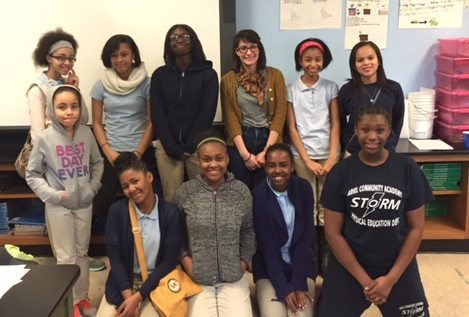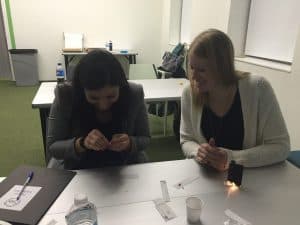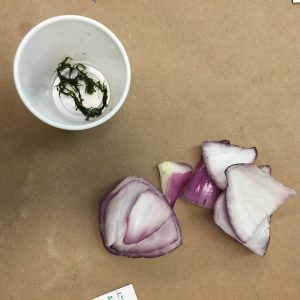A PhD. candidate in the University of Chicago’s Evolutionary Biology department, Joyce Pieretti has been a frequent visitor to Sisters4Science since Fall, 2014. Below she shares her experience at a recent professional development meeting for Project Exploration’s guest scientists.
Have you heard the one that goes, “So a scientist walks into a classroom…?” No? Well, let me tell you a little backstory first.
Ask a scientist about their work, and they will hopefully be able to explain what they do in plain English. Now, if they can’t do that, it may not be because they lack enthusiasm; in fact, they may just not know how to speak about their science effectively with the public. Effective science communication is a skill-set that scientists must build upon and improve. Thankfully, Project Exploration is here.
On Saturday, February 21, I participated in PE’s “Day of Engagement” for scientists participating in Sisters4Science and other PE programs. Run by Dr. Stephanie Levi, who evaluates PE’s science programming, the meeting had several goals: (1) Ensure that all visiting scientists understand the goals of the program; (2) show how S4S has positively impacted young girls from underrepresented backgrounds in the Chicago Public School system; and (3) demonstrate teaching strategies that can improve our lessons for these girls.
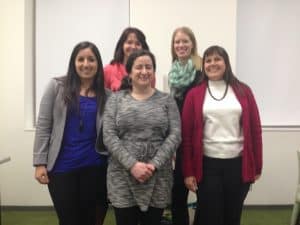 One of the tidbits of knowledge I was most impressed by was the fact that 25.8% of students noted an increased interest in science careers as a result of participation in the program. In spite of the barriers to science education among minorities, S4S is making a substantial difference in how youth perceive themselves as potential scientists.
One of the tidbits of knowledge I was most impressed by was the fact that 25.8% of students noted an increased interest in science careers as a result of participation in the program. In spite of the barriers to science education among minorities, S4S is making a substantial difference in how youth perceive themselves as potential scientists.
Stephanie began by asking what we thought were the ideal traits a mentor exhibits and the type of support one may offer. Our responses centered on being encouraging and approachable, providing access to helpful resources, and being someone that a student can relate to on a personal level.
This last trait is possibly the most motivating factor in why I participate in S4S. As a Hispanic female scientist, I am aware of the stark realities of diversity and the struggle to improve it in higher education. Everyone’s path to science is different, but if I help at least one person, showing her that she does not have to be a grey-haired white male in a lab coat to be considered a scientist, then I will consider that a job well done.
But to genuinely do that job well, we scientists need to know and practice the skills that are needed to effectively teach and keep young girls engaged. To help with this, we were introduced to the “5E” model of science learning:
(1) Engage: Engage the students and foster excitement and enthusiasm about the topic.
(2) Explore: Have students explore and investigate a problem, ask questions, and interact with the topic
(3) Explain: Let students explain and develop their understanding about the concept or skill being taught.
(4) Elaborate: Provide opportunities for the student to elaborate by applying and refining their understanding in a new context.
(5) Evaluate: The facilitator can follow up by evaluating student learning and their own teaching through an assessment.
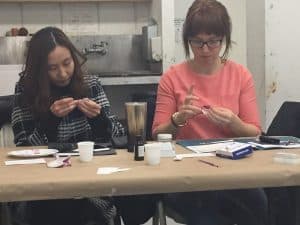 After discussing some case scenarios of different science lessons implementing the 5E model, we began modeling a lesson on chloroplasts in plant cells. First, we shared what we already knew about plant cells, chloroplasts, and photosynthesis. Then we modeled a hypothesis that students would likely pose when doing this lesson, such as “Do roots have chloroplasts?” To explore this question, we prepared slides that had aquatic Elodea leaves and peeled onionskins stained with iodine to visualize the cells more easily. To magnify the plant cells, we used portable microscopes that fit in the palms of our hands and came equipped with a small lens and battery-powered light source. I often use large and bulky dissecting microscopes to look at live zebrafish, so the fact that there was a handheld scope (I could carry it around in a tote bag!) was a real treat!
After discussing some case scenarios of different science lessons implementing the 5E model, we began modeling a lesson on chloroplasts in plant cells. First, we shared what we already knew about plant cells, chloroplasts, and photosynthesis. Then we modeled a hypothesis that students would likely pose when doing this lesson, such as “Do roots have chloroplasts?” To explore this question, we prepared slides that had aquatic Elodea leaves and peeled onionskins stained with iodine to visualize the cells more easily. To magnify the plant cells, we used portable microscopes that fit in the palms of our hands and came equipped with a small lens and battery-powered light source. I often use large and bulky dissecting microscopes to look at live zebrafish, so the fact that there was a handheld scope (I could carry it around in a tote bag!) was a real treat!
As I peered into the microscope’s eyepiece, a rectangular-shaped image slowly came into focus. And there they were—the plant cells. In the elodea slide they were a bright spring green, but in the onion, no such color could be detected, save the murky yellow-brown from the iodine. After this exploration, we reconvened and practiced explaining to others what we saw. Stephanie noted that in an actual lesson we could encourage different levels of thinking by asking students to elaborate on the chloroplast and it’s function in the cell, by either drawing what they visualized or by writing a short personified description of a cell. Finally, as part of an evaluation, we discussed how we could further expand the lesson for students. For example, by broadening the hypothesis to other types of root vegetables or learning the colors seen in autumn leaves, students can learn about the other types of cells that contain pigments.
The 5E model serves as a template through which we can build captivating and educational science lessons that students can understand. Indeed, when I implemented it to one of my lessons on natural selection, it proved to be a useful guide to help keep students engaged and excited about the topic. So, have you heard the one about a scientist walking into a classroom? Well, she walked in and showed the girls that science is a diverse and exciting field, ushering them to come learn and explore.
